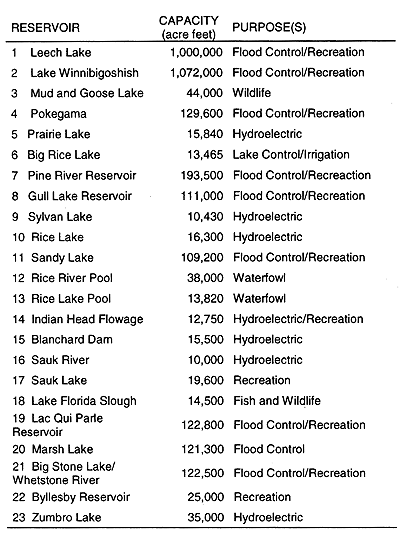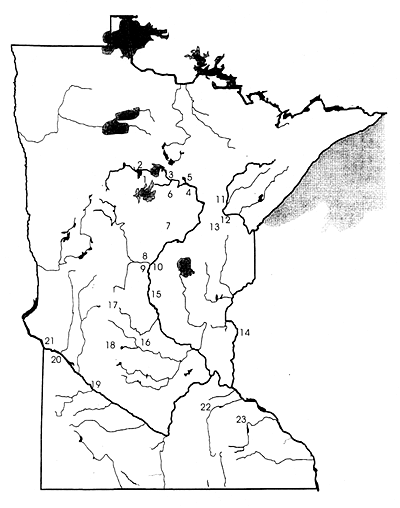 |
 |
Constructing, Maintaining and Operating Public Dams, Reservoirs and Navigation Related Facilities
Federal, state and local governmental agencies, as well as private individuals, own and operate dams, reservoirs, and navigation of facilities on Minnesota’s rivers. These dams and associated reservoirs provide a variety of services, such as: flood control, hydroelectric power, recreation, fish and wildlife habitat and irrigation (see Figure 4.2).


Figure 4.2 Minnesota’s Main Reservoirs and Dams. UMRBC, 1981.
The U.S. Army Corps of Engineers (Corps) operates and maintains the navigation system on the Upper Mississippi River, including the headwaters reservoirs, locks, dams, channels, levees, and pools associated with the locks and dams on the river below St. Anthony Falls. The Corps maintains a nine-foot-deep channel by periodic dredging, and makes modifications to the system as deemed necessary.
The Corps operates the reservoirs based on guidelines established in an informal agreement with the state of Minnesota. The headwaters reservoirs, constructed primarily for flood control and to ensure sufficient flows for navigation, serve primarily to maintain lake levels for recreation. Reservoir level maintenance also provides benefits for the Leech Lake Band of Chippewa’s wild rice production and harvesting. A lower priority objective is to augment river flow when low-flow conditions threaten Twin Cities’ water supply and waste water systems. The Corps also operates flood control and low-flow augmentation projects on other Minnesota rivers, such as the Minnesota, Otter Tail, Bois de Sioux, and Red Lake rivers.
The DNR’s Surface Water and Hydrographics Section within the Waters Division bears responsibility for examination, maintenance and repair of approximately 315 state-owned dams. Local governments and private landowners own and maintain dams built to protect agricultural land and towns from flooding. The federal Natural Resources Conservation Service built many of these dams and then turned them over to local or private ownership. In addition, private companies and local governments operate dams and related reservoirs for power generation. The DNR inspects all private and public dams and associated structures and administers a grant program to local governments that provides up to 50% of the cost to repair locally owned dams.